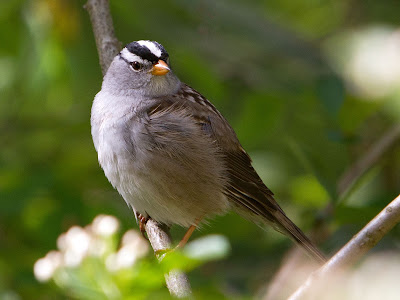For the Birds: Not all Sparrows are Little Brown Jobs
Tuesday, November 9, 2021
 |
| Fox sparrow in leaves. Photo by Craig Kerns |
When most people hear the word “sparrow”, they usually think of hard-to-identify brown birds, “LBJ’s” in birding parlance (little brown jobs) and many people look for other more colorful birds.
Song Sparrows are probably our most common resident bird — almost every yard that has trees and/or shrubs has a Song Sparrow or two that eats insects, especially ground insects and weed seeds. These birds really do help keep your yard healthy and should be encouraged into your yard.
Every spring and fall they belt out their delightful song for which they were so aptly named. They are one of those “little brown jobbies”.
 |
| Song Sparrow eating blackberries. Photo by Elaine Chuang |
Their favorite winter locations are in/under protecting Himalayan Blackberries.
Blackberry brambles always have bugs, seeds and old fruits to eat, provide the dense habitat that they prefer, mitigate cold temperatures, and keep out most predators.
Our sub-species, Sooty Fox Sparrow, is such a pretty bird with its two-toned bill, a solid brown back, and chevron-marked breast.
Our sub-species, Sooty Fox Sparrow, is such a pretty bird with its two-toned bill, a solid brown back, and chevron-marked breast.
To find this usually solitary bird look for a slightly larger, dark sparrow under the edges of shrubs or deep in thick leaves with a chocolate colored back, not a streaked brown back, doing its two-footed-leaf-kicking activity, and you have likely found a Fox Sparrow in your yard.
 |
| White-crowned Sparrow. Photo by Craig Kerns |
Both species actually stay in open areas in the Puget Sound area, but they usually aren’t in our yards during the winter. I hear them passing through every late spring and late fall.
Their heads really do have white-crowns or yellowish-gold crowns (at least on the adults), and most people don’t think of them as being LBJs once they take a good look at them.
Dark-eyed Juncos and Spotted Towhees are also sparrows, but no one would call them LBJs.
Dark-eyed Juncos and Spotted Towhees are also sparrows, but no one would call them LBJs.
 |
| Golden-crowned Sparrow. Photo by Craig Kerns |
Keeping your leaves under your shrubs enriches your soil and provides bird food stockpiles.
If you make even a small brush pile it will invite birds to over-winter in your yard.
High fat suet (and nectar for hummingbirds) help provide life-saving energy for our local wild birds, especially during cold temperatures.
And it is satisfying to know you are helping make a difference.
Read previous For the Birds columns HERE
Read previous For the Birds columns HERE




0 comments:
Post a Comment